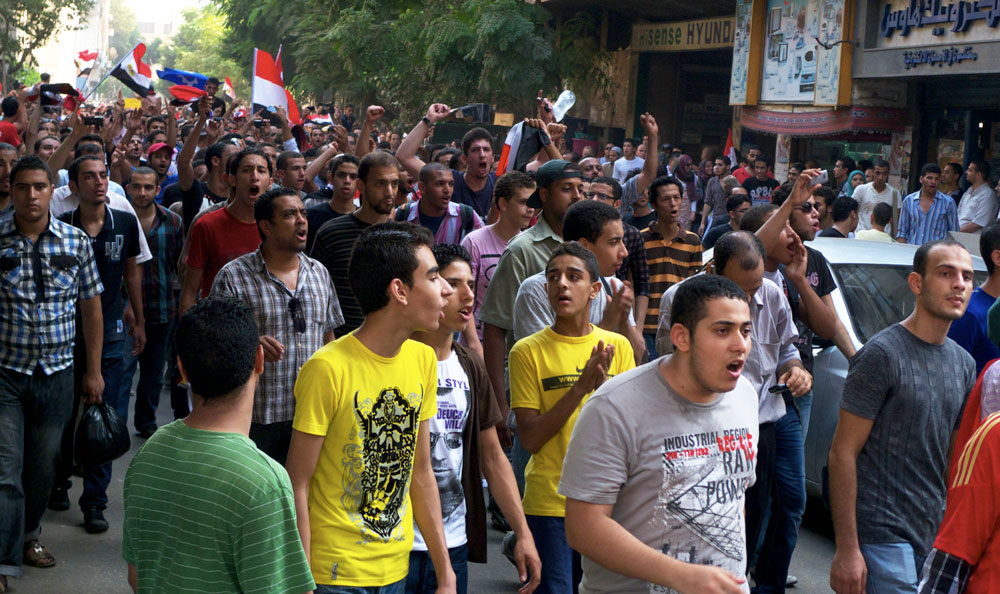Almost seven months after the fall of Mubarak, the revolution in Egypt is far from over. The old regime is still in power and the masses can feel the revolution slipping through their fingers. Everything has changed, and yet everything remains the same. However, the anger of workers and youth has not gone away as the recent spate of strikes indicates.
The bourgeois media in Britain and elsewhere prefer, on the other hand, to concentrate on other issues, such as last week’s storming of the Israeli embassy in Cairo. They have jumped on this incident, displaying images of burning Israeli flags, to try and distract from the real revolutionary events taking place both in Egypt and in Israel itself (Israel witnesses biggest march in its history, In Defence of Marxism, 5th September).
The New York Times referred to the attack – in an article entitled “Beyond Cairo, Israel Sensing a Wider Siege” –as a “diplomatic crisis, in which winds unleashed by the Arab Spring are now casting a chill over the region”. The New York Times goes on to describe the scene of “Israeli military jets sweeping into Cairo at dawn on Saturday to evacuate diplomats after the Israeli Embassy had been besieged by thousands of protesters.” (Beyond Cairo, Israel Sensing a Wider Siege, New York Times, 10th September 2011).
Later on in the same article, the comparison is made to the events of the Iranian revolution in 1979: “It was an image that reminded some Israelis of Iran in 1979, when Israel evacuated its embassy in Tehran after the revolution there replaced an ally with an implacable foe...”
“...‘Egypt is not going toward democracy but toward Islamicisation,’ said Eli Shaked, a former Israeli ambassador to Cairo who reflected the government’s view. ‘It is the same in Turkey and in Gaza. It is just like what happened in Iran in 1979’.”
The implication being made here is clear. Once again the bourgeois media and politicians are attempting to whip up a sense of hysteria around the Arab revolutions. The representatives of the capitalist class have always used the example of the Iranian revolution as a stick to beat any revolutionary movement in the Arab world with, ever since the theocratic Ayatollahs filled the political vacuum and hijacked the revolution in 1979, in essence crushing the revolution and carrying out a counter-revolution. Their message is essentially this: “Don’t think about giving the people in the Arab countries any freedoms. If you do, the Islamic fundamentalists will take power and will destroy Israel – the bastion of democracy in the Middle East! What we need is a leader that will provide stability!”
Such hysteria is completely unfounded. As has been seen in the Arab revolutions so far – and especially in the Egyptian revolution – the Islamic groups, such as the Muslim Brotherhood, have not played a leading role and have actually distanced themselves from the movement. (This was seen again last Friday when the Muslim Brotherhood opposed the mass protests.) The Egyptian revolution was notable for its distinct lack of any religious character, and images were frequently seen of Muslim, Coptic and secular Egyptians demonstrating side by side.
The context of the demonstrations
The attack on the Israeli embassy will undoubtedly also be used by the Israeli state, which uses such attacks to justify its “siege mentality”, i.e. its large state apparatus and aggressive military policy, but it will also be used by the Egyptian Military Council, which has now announced the return of “emergency law”, allowing the use of extra-judicial detentions and live ammunition in order to prevent protests. But all the hue and cry over the attack is in fact aimed at deflecting attention away from the really important developments that are taking place in Egypt.
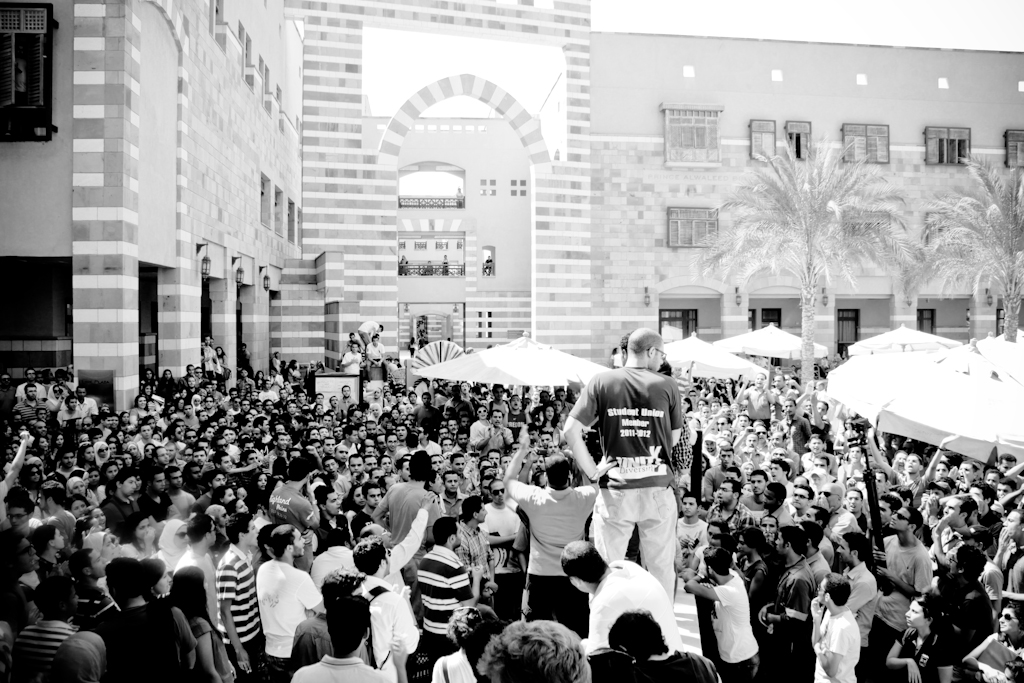 Rally for the AUC strike, September 12. Photo: Maggie Osama The events of Friday, September 9, can only be understood in the context of a whole week of escalating class struggle. In the run up to the day of action a wave of strikes was developing, involving key sectors of the working class in Cairo and across Egypt. An example of this was seen on Sunday 11th September, with the beginnings of a student and worker strike at the American University in Cairo (AUC). Students demanding lower tuition fees were joined by university bus drivers, cleaners, and security staff demanding higher wages and shorter working days. This strike follows on from other recent strikes and threats of strike action in both the public and private sector, as trade unionists become further disillusioned by the failed promises of Prime Minister Essam Sharaf and the Military Council.
Rally for the AUC strike, September 12. Photo: Maggie Osama The events of Friday, September 9, can only be understood in the context of a whole week of escalating class struggle. In the run up to the day of action a wave of strikes was developing, involving key sectors of the working class in Cairo and across Egypt. An example of this was seen on Sunday 11th September, with the beginnings of a student and worker strike at the American University in Cairo (AUC). Students demanding lower tuition fees were joined by university bus drivers, cleaners, and security staff demanding higher wages and shorter working days. This strike follows on from other recent strikes and threats of strike action in both the public and private sector, as trade unionists become further disillusioned by the failed promises of Prime Minister Essam Sharaf and the Military Council.
In the public sector, postal workers have been on strike for over two weeks demanding a 7% annual pay increase to keep up with inflation, along with the removal of corrupt officials in the postal service from the Mubarak era who are still in power. Similar demands for higher wages and against corruption in the public sector have led doctors, teachers, and university professors to threaten strike action later in September. According to Ahram Online:
“Teachers and university professors are also preparing for nationwide actions in the middle of the month over wages, work conditions and issues of workplace democracy.
“A recent spike in strike action seems to reflect a sense that many workers in the public sector have run out of patience with Sharaf’s government, which made a number of promises to the public to improve living standards when it first took office last March, but has not adequately delivered...
“...Sharaf’s cabinet has also failed so far to put a cap on the excessive salaries it pays to top officials in the public sector, a widely popular demand among public sector workers.
“To add insult to injury, many workers think that Sharaf has, for the most part, treated Mubarak-era officials with kid gloves, and dismissed only a handful from high positions.
“In fact, most Egyptian workers across the country come to work every morning, seven months after they played a key role in toppling the former dictator, to be greeted by the same old bureaucrats and authoritarian figures from the Mubarak years.” (Egyptian Postal workers strike a big headache for SCAF, Ahram Online, 7th September)
In the private sector, engineers have been threatening strike action and 22,000 workers at the country’s largest textile factory in Mahallah, who have consistently been at the forefront of industrial struggles over the last five or six years, began an open-ended strike on the 10th September over wages and benefits.
The slow pace of change
The occupation of the Israeli embassy was not the main event of the day, but followed on from a demonstration in the famous Tahrir Square, where tens of thousands had gathered to protests against the slow pace of change that has followed the departure of Mubarak in February earlier this year. As we have reported previously (Masses return to the Streets in Egypt, In Defence of Marxism, 11th July), the workers and youth in Egypt are frustrated and angered by the complete lack of progress that has been made by the Military Council regime, either in terms of political or economic change. The statement made by the Union of Egyptian Socialist Youth (UESY) in advance of last Friday’s protest sums up the situation facing the masses in Egypt:
“Seven months since the victory of the first wave of the revolution that toppled Hosni Mubarak, and the revolution still has not achieved its goals. All that has been achieved is the bloodshed of our martyrs and our comrades. The ranks of the counter-revolutionaries have organised throughout this period, including the Islamic forces and the military rulers. They claim that the revolution has ended, but the revolutionary forces will not stop, and the revolution will not end until the achievement of its objectives.
“The system is still the same as that which ruled in the era of Mubarak; it is still biased in favour of the capitalist class, which sucks the blood of our poor, and steals billions of dollars to support the rich. Whilst this regime leans on the support of the poor, they are running away from the demands for a minimum wage, a maximum wage, and for decent pensions, and they have sentenced many protestors in military trials.
“We in the Union of Socialist Youth consider the Military Council and the Government of Essam Sharaf to be but a continuation of the Mubarak regime. We emphasise the need to spread the slogan of the revolution, ‘the people want to overthrow the regime’, which affirms that we want to get rid of the old system and all its symbolic gestures of economic and social development.
“We emphasise that we will not accept half a revolution; we will not deprive Egypt's poor of their social, economic, and political rights. The current ‘rights’ do not guarantee the equitable distribution of wealth and do not guarantee real democracy in either its social form or its political form. We will not accept a revolution that does not protect the Constitution of the people, does not provide jobs for youth, and does not grant independent jurisdiction. We will not accept any electoral laws that impose a distorted revolution and do not give the right to vote to Egyptians living abroad. We will continue our revolution until victory, until all these objectives are met.”
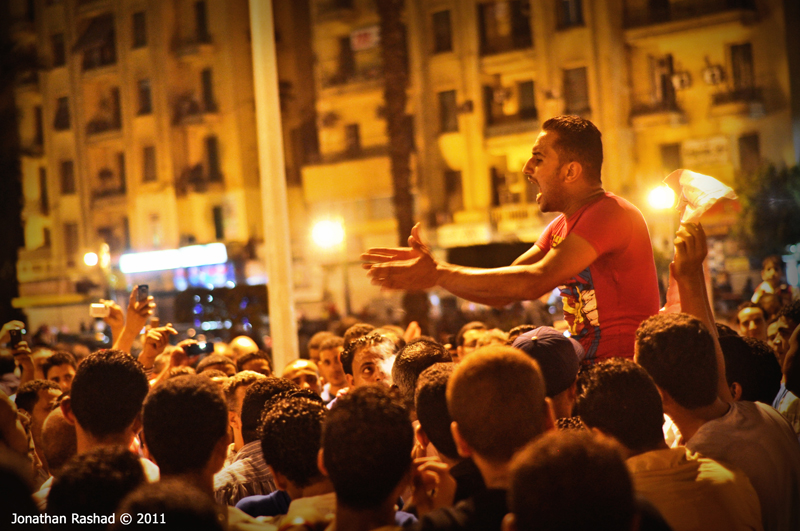 September 9. Photo: Jonathan Rashad These words express the real situation facing workers and youth in Egypt. The tragedy, as ever, is the lack of a revolutionary leadership to point the way forward and present an alternative. The UESY is playing a positive role, but they are not a mass force and their resources are limited. Meanwhile, the self-appointed “leaders” of the January 25th movement, such as the “Coalition of Revolutionary Youth”, which includes the representatives of the Muslim Brotherhood Youth and the supporters of UN official El Baradei, has a programme that is completely devoid of any social or economic demands. As has been pointed out earlier, the Muslim Brotherhood is in fact distancing itself from the movement, and opposing the most recent protest
September 9. Photo: Jonathan Rashad These words express the real situation facing workers and youth in Egypt. The tragedy, as ever, is the lack of a revolutionary leadership to point the way forward and present an alternative. The UESY is playing a positive role, but they are not a mass force and their resources are limited. Meanwhile, the self-appointed “leaders” of the January 25th movement, such as the “Coalition of Revolutionary Youth”, which includes the representatives of the Muslim Brotherhood Youth and the supporters of UN official El Baradei, has a programme that is completely devoid of any social or economic demands. As has been pointed out earlier, the Muslim Brotherhood is in fact distancing itself from the movement, and opposing the most recent protest
Protest at Israeli embassy
As the protestors in Tahrir Square dispersed later in the afternoon, many headed towards the Israeli embassy in Giza, a suburb of Cairo. There has been a great deal of anger towards Israel in Egypt since the killing of six Egyptian border guards by the Israeli army in August, and the Israeli embassy in Cairo has been the target of several protests in the weeks since.
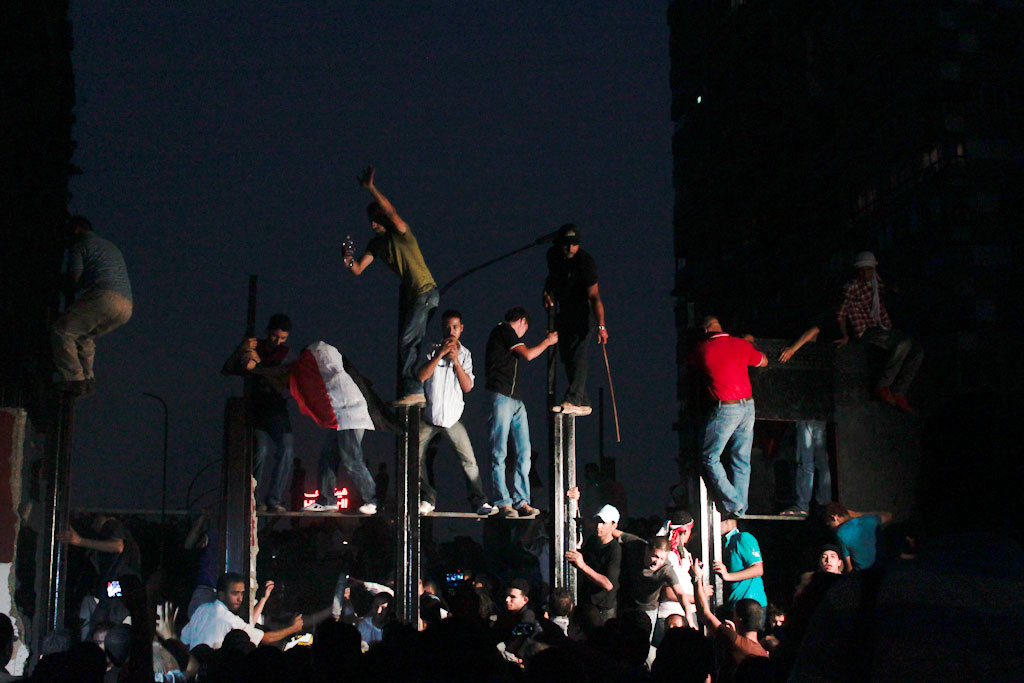 Barricade at Israeli embassy being torn down. Photo: Maggie Osama Reports of the embassy protest indicate crowds of over 5000, with a variety of layers including students, workers, and football supporters’ clubs. The protective wall that had been built to protect the embassy was shaken and then destroyed. Hundreds stormed the building, climbing to the roof in order to bring down the Israeli flag for the second time in the last few weeks. It was not long before the Central Security Forces (CSF), the Egyptian riot police, turned up and began firing canisters of tear gas into the crowds – canisters that were engraved with “Made in USA”. Some protestors eventually broke into the document archives within the embassy and began to shower the crowds below with papers. One eyewitness on Ahram Online, an English language Egyptian news website, describes the content of these official documents:
Barricade at Israeli embassy being torn down. Photo: Maggie Osama Reports of the embassy protest indicate crowds of over 5000, with a variety of layers including students, workers, and football supporters’ clubs. The protective wall that had been built to protect the embassy was shaken and then destroyed. Hundreds stormed the building, climbing to the roof in order to bring down the Israeli flag for the second time in the last few weeks. It was not long before the Central Security Forces (CSF), the Egyptian riot police, turned up and began firing canisters of tear gas into the crowds – canisters that were engraved with “Made in USA”. Some protestors eventually broke into the document archives within the embassy and began to shower the crowds below with papers. One eyewitness on Ahram Online, an English language Egyptian news website, describes the content of these official documents:
“We caught the papers and examined them. It took hundreds of people a few minutes of sorting through them before we realised that we were looking at Israeli Embassy records in Arabic, Hebrew and English...
“...There were records of phone deals between major Egyptian private and public telecommunications firms and Israel. I also saw documents that listed names of business transactions between the embassy and all sorts of Egyptian authorities, from customs officials to CEOs of tourism firms, bringing Israeli travellers to Egypt, and on and on.
“Much of the confetti that was dropping on us dated back to the 1990s and even the 1980s, as its typeset indicated.
“The revolutionaries upstairs sent at least six or seven separate sets of documents on us every 10 minutes or so for a whole hour. TV cameras hustled to interview dozens of people with documents that they believed showed the depth of the embassy’s penetration into the economic and political scene in Egypt.” (The storming of Cairo’s Israeli embassy: an eyewitness account, 10th September, Ahram Online, our emphasis)
Here we can see yet another reason why ordinary Egyptians are angered by the Israeli state, whose tentacles reach all the way into the daily activity in all areas of Egyptian society. In this respect, much of the anger felt by Egyptian workers and youth is a healthy opposition to Zionism and the imperialist Israeli state that intervenes militarily and economically across the Middle East, in Egypt, Palestine, and Lebanon.
“Correct the Path” Friday
The events at the Israeli embassy last week have to be put into the general context of the situation that exists in Egypt today, months after the fall of Mubarak. It is not by chance that last Friday was dubbed “Correct the Path” day. There is a widespread feeling that although Mubarak has gone, his regime still stands. Many key positions are held by people who were heavily involved in the old regime.
Last Friday saw several protests across Egypt, with Tahrir Square once again at the centre of the mobilisations. Five hundred students marched from the American University in Cairo. Demonstrators were chanting slogans against the ruling military council, against military trials and, significantly, for the implementation of fair minimum wages. Football supporters’ clubs were also involved. In fact members of the Zamalek Football supporters’ club, in an unprecedented show of unity, joined their rival supporters at the Ahly club in taking part in the protests, and in the process changing their usual football stadium singing into political slogans against the ruling military council and the police.
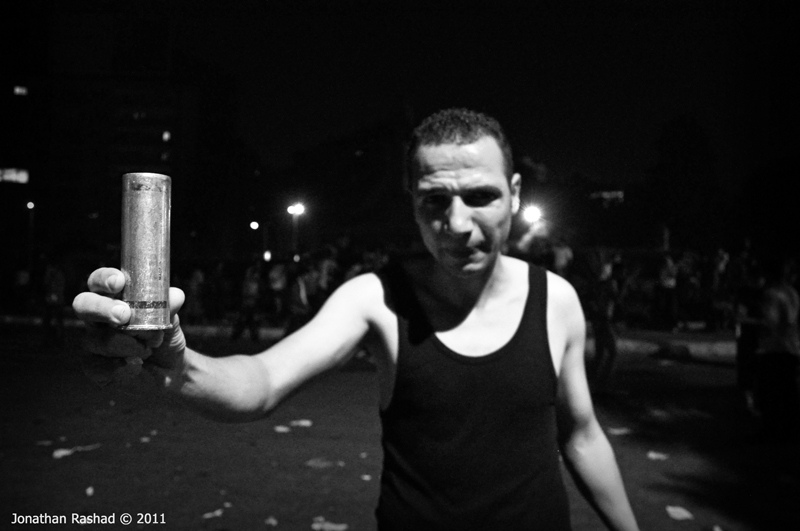 Clashes outside the Israeli embassy. Protester holding US manufactured tear gas canister. Photo: Jonathan Rashad Among the slogans heard on the marches one could hear the call for “change, freedom and social justice”. Another significant slogan was “One, Two, where did the revolution go?” When protestors passed by the Saudi Arabian embassy, they chanted “Mubarak and Saudi Arabia are one hand.” The football supporters concentrated their attention on the Interior Ministry, setting up camp in front of the ministry building, chanting “We've not forgotten Tahrir, you sons of *****”.
Clashes outside the Israeli embassy. Protester holding US manufactured tear gas canister. Photo: Jonathan Rashad Among the slogans heard on the marches one could hear the call for “change, freedom and social justice”. Another significant slogan was “One, Two, where did the revolution go?” When protestors passed by the Saudi Arabian embassy, they chanted “Mubarak and Saudi Arabia are one hand.” The football supporters concentrated their attention on the Interior Ministry, setting up camp in front of the ministry building, chanting “We've not forgotten Tahrir, you sons of *****”.
In Alexandria protesters shouted “No to the military council’s monopolisation of power” and “Put all the murderous officers on trial”. Again, referring to the slow pace of the revolution, they chanted “Everything is the same even after the revolution.” In Suez there were similar protests.
One small but significant detail was the fact that Abdel Hakim Abdel Nasser, the youngest of former president Nasser’s sons, spoke from the main platform in Tahrir Square while the protestors chanted pro-Nasser slogans. This confirms the fact that the memory of Nasser is not dead in Egypt, and he still embodies what many see as the period of anti-imperialist struggle in the 1950s and 1960s. (Nasser and the Arab revolution, In Defence of Marxism, 12th May).
Who is the real enemy of the Egyptian workers and youth?
It is undeniable that reactionary elements within Egypt will attempt to whip up anti-Semitism and racism towards all Israelis as a means of cutting across the class struggle that has erupted on a higher level in the recent period. The capitalists, the military rulers, and the Islamists in Egypt will do anything they can to prevent solidarity between Egyptian and Israeli workers. In this way the ruling classes in Egypt and Israel enter into a symbiotic relationship, with attacks by one against the other providing the justification for the oppression of the working class in both.
However, the answer to any prejudices and racism that may exist amongst ordinary Arabs and Jews towards one another can be seen in the events taking place in Israel right now. The tremendous movement of over 500,000 Israelis for social justice has clearly been inspired by the Arab revolutions, and especially the Egyptian revolution, with tent cities being formed in cities such as Tel Aviv, and slogans that employ almost identical language to that seen during the 25th January movement in Egypt. Indeed, the Israeli movement is composed of both Arabs and Jews, and many of the chants have been in a mixture of Hebrew and Arabic. It is through the common struggle of workers and youth against the oppressive and exploitative regimes across the Middle East that the old tactic of “divide and rule” will be undermined and unity on a class basis will be achieved.
The enemy of the Egyptian workers are not the workers and youth of Israel. Their enemy is the Zionist ruling class in Israel and the Egyptian ruling class, as well as the elites in countries like Saudi Arabia. In fact there was an attempt to attack the Saudi embassy in Cairo on the same day, but the police managed to hold the protestors back, but this gets less highlighted in the bourgeois media. It is in the interests of the ruling classes of both Israel and Egypt that national divisions should be fomented and strengthened. It is in the interests of the workers in Egypt and Israel that national barriers should be brought down and a common struggle should be promoted of all workers against their respective bosses and rulers.
Not a light-bulb shines, not a telephone rings...
The solution to the problems faced by Egyptian workers and youth is to be found in the strength of workers and youth themselves, who, when organised, are an unstoppable force. One should not forget that it was the wave of mass strike action during the revolutionary events of January and February that finally led to the toppling of Mubarak.
The development of the movement on class lines is a clear threat to the old rulers who still control the Egyptian state. The strikes, the escalating demands for nationalisation, the explosions among the youth, all these examples paint a picture of the real situation in the Egyptian revolution, which is one of organised class struggle, not of “riots” as the media would like us to believe. It is through these struggles that the workers and youth in Egypt will learn and gain a sense of their own power – the power to run society in their own interests, not in the interests of the military rulers and the capitalist class that they maintain. As is often said, not a light-bulb shines, not a wheel turns, and not a telephone rings without the kind permission of the working class.
[Note: we will shortly be following up on this article with more detailed accounts of the strikes that have been taking place.]
